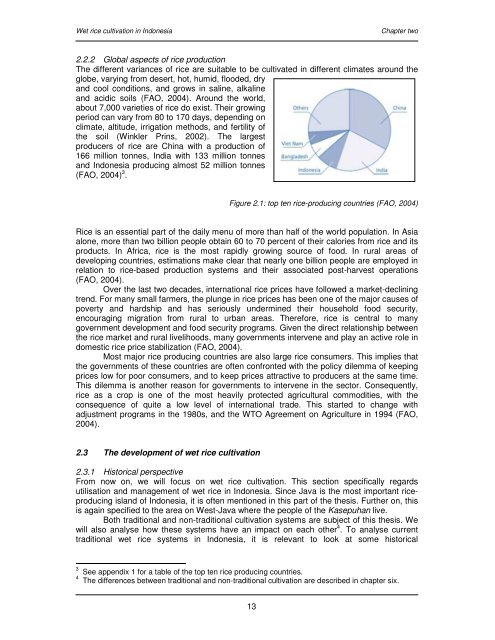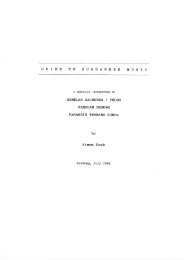Wet rice cultivation in Indonesia - Free EBooks Library
Wet rice cultivation in Indonesia - Free EBooks Library
Wet rice cultivation in Indonesia - Free EBooks Library
You also want an ePaper? Increase the reach of your titles
YUMPU automatically turns print PDFs into web optimized ePapers that Google loves.
<strong>Wet</strong> <strong>rice</strong> <strong>cultivation</strong> <strong>in</strong> <strong>Indonesia</strong> Chapter two<br />
2.2.2 Global aspects of <strong>rice</strong> production<br />
The different variances of <strong>rice</strong> are suitable to be cultivated <strong>in</strong> different climates around the<br />
globe, vary<strong>in</strong>g from desert, hot, humid, flooded, dry<br />
and cool conditions, and grows <strong>in</strong> sal<strong>in</strong>e, alkal<strong>in</strong>e<br />
and acidic soils (FAO, 2004). Around the world,<br />
about 7,000 varieties of <strong>rice</strong> do exist. Their grow<strong>in</strong>g<br />
period can vary from 80 to 170 days, depend<strong>in</strong>g on<br />
climate, altitude, irrigation methods, and fertility of<br />
the soil (W<strong>in</strong>kler Pr<strong>in</strong>s, 2002). The largest<br />
producers of <strong>rice</strong> are Ch<strong>in</strong>a with a production of<br />
166 million tonnes, India with 133 million tonnes<br />
and <strong>Indonesia</strong> produc<strong>in</strong>g almost 52 million tonnes<br />
(FAO, 2004) 3 .<br />
Figure 2.1: top ten <strong>rice</strong>-produc<strong>in</strong>g countries (FAO, 2004)<br />
Rice is an essential part of the daily menu of more than half of the world population. In Asia<br />
alone, more than two billion people obta<strong>in</strong> 60 to 70 percent of their calories from <strong>rice</strong> and its<br />
products. In Africa, <strong>rice</strong> is the most rapidly grow<strong>in</strong>g source of food. In rural areas of<br />
develop<strong>in</strong>g countries, estimations make clear that nearly one billion people are employed <strong>in</strong><br />
relation to <strong>rice</strong>-based production systems and their associated post-harvest operations<br />
(FAO, 2004).<br />
Over the last two decades, <strong>in</strong>ternational <strong>rice</strong> p<strong>rice</strong>s have followed a market-decl<strong>in</strong><strong>in</strong>g<br />
trend. For many small farmers, the plunge <strong>in</strong> <strong>rice</strong> p<strong>rice</strong>s has been one of the major causes of<br />
poverty and hardship and has seriously underm<strong>in</strong>ed their household food security,<br />
encourag<strong>in</strong>g migration from rural to urban areas. Therefore, <strong>rice</strong> is central to many<br />
government development and food security programs. Given the direct relationship between<br />
the <strong>rice</strong> market and rural livelihoods, many governments <strong>in</strong>tervene and play an active role <strong>in</strong><br />
domestic <strong>rice</strong> p<strong>rice</strong> stabilization (FAO, 2004).<br />
Most major <strong>rice</strong> produc<strong>in</strong>g countries are also large <strong>rice</strong> consumers. This implies that<br />
the governments of these countries are often confronted with the policy dilemma of keep<strong>in</strong>g<br />
p<strong>rice</strong>s low for poor consumers, and to keep p<strong>rice</strong>s attractive to producers at the same time.<br />
This dilemma is another reason for governments to <strong>in</strong>tervene <strong>in</strong> the sector. Consequently,<br />
<strong>rice</strong> as a crop is one of the most heavily protected agricultural commodities, with the<br />
consequence of quite a low level of <strong>in</strong>ternational trade. This started to change with<br />
adjustment programs <strong>in</strong> the 1980s, and the WTO Agreement on Agriculture <strong>in</strong> 1994 (FAO,<br />
2004).<br />
2.3 The development of wet <strong>rice</strong> <strong>cultivation</strong><br />
2.3.1 Historical perspective<br />
From now on, we will focus on wet <strong>rice</strong> <strong>cultivation</strong>. This section specifically regards<br />
utilisation and management of wet <strong>rice</strong> <strong>in</strong> <strong>Indonesia</strong>. S<strong>in</strong>ce Java is the most important <strong>rice</strong>produc<strong>in</strong>g<br />
island of <strong>Indonesia</strong>, it is often mentioned <strong>in</strong> this part of the thesis. Further on, this<br />
is aga<strong>in</strong> specified to the area on West-Java where the people of the Kasepuhan live.<br />
Both traditional and non-traditional <strong>cultivation</strong> systems are subject of this thesis. We<br />
will also analyse how these systems have an impact on each other 4 . To analyse current<br />
traditional wet <strong>rice</strong> systems <strong>in</strong> <strong>Indonesia</strong>, it is relevant to look at some historical<br />
3 See appendix 1 for a table of the top ten <strong>rice</strong> produc<strong>in</strong>g countries.<br />
4 The differences between traditional and non-traditional <strong>cultivation</strong> are described <strong>in</strong> chapter six.<br />
13








